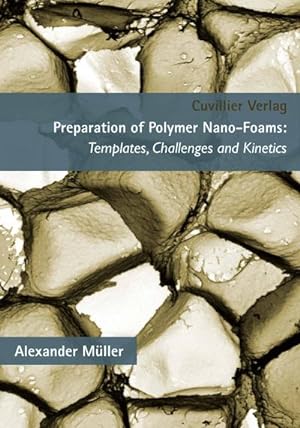preparation polymer nano foams templates di müller alexander (2 risultati)
Tipo di articolo
- Tutti gli articoli
- Libri (2)
- Riviste e Giornali
- Fumetti
- Spartiti
- Arte, Stampe e Poster
- Fotografie
- Mappe
-
Manoscritti e
Collezionismo cartaceo
Condizioni
- Tutte
- Nuovi
- Antichi o usati
Legatura
- Tutte
- Rilegato
- Brossura
Ulteriori caratteristiche
- Prima edizione
- Copia autografata
- Sovraccoperta
- Con foto
- No print on demand
Paese del venditore
Valutazione venditore
-
Preparation of Polymer Nano-Foams. Templates, Challenges and Kinetics
Editore: Cuvillier Nov 2013, 2013
ISBN 10: 3954045664ISBN 13: 9783954045662
Da: BuchWeltWeit Ludwig Meier e.K., Bergisch Gladbach, Germania
Libro Print on Demand
Taschenbuch. Condizione: Neu. This item is printed on demand - it takes 3-4 days longer - Neuware -The current energy debate considerably affects science, economy and politics. A key aspect of this discussion is energy saving by improvement of thermal insulations for buildings. In this regard, nano insulation materials (NIMs) are the insulation materials of the future. If additionally, a pore size reduction to nanoscale results in optical transparency, completely new markets for polymer foams will arise. However, the realization of these high-potential materials is accompanied by many challenges, as for example the extremely high interfacial tension emerging during foaming processes that cause an undesired coarsening of the foam structure. To overcome these challenges, new strategies and templates have to be scientifically developed. Moreover, it is crucial to understand the foaming in detail. In this context the early state of foaming was studied by means of the principle of supercritical microemulsion expansion (POSME). The benefit of using microemulsions containing a super- or near-critical fluid as oil component is the thermodynamic stability at high pressures. This allows a fast repeatability of the expansion process at nanoscale by applying pressure cycles. In combination with a specially designed stroboscopic high pressure cell, the structural processes could be observed by time resolved small angle neutron scattering experiments. It turned out that the addition of a low molecular oil as anti aging agent results in a deceleration of foam coarsening during expansion by more than an order of magnitude. Parallel to these studies, the nanofoams by continuity inversion of dispersions (NF-CID) principle was utilized for the preparation of nanoporous polymeric materials. The significant innovation of the NF-CID principle is the generation of an extremely high number density of propellant pools by a continuity inversion of a CO2-soaked colloidal crystal, i.e. the formerly discrete polymer nanoparticles convert into a homogeneous matrix with nanodisperse fluid inclusions, if the temperature is raised above the glass transition of the respective polymer. Expanding those templates by applying a specific set of parameters led to polymethylmethacrylate and polystyrene nanoporous materials that feature pore sizes smaller than 100 nm. 240 pp. Englisch.
-
Preparation of Polymer Nano-Foams. Templates, Challenges and Kinetics
Editore: Cuvillier
ISBN 10: 3954045664ISBN 13: 9783954045662
Da: AHA-BUCH GmbH, Einbeck, Germania
Libro Print on Demand
Taschenbuch. Condizione: Neu. nach der Bestellung gedruckt Neuware - Printed after ordering - The current energy debate considerably affects science, economy and politics. A key aspect of this discussion is energy saving by improvement of thermal insulations for buildings. In this regard, nano insulation materials (NIMs) are the insulation materials of the future. If additionally, a pore size reduction to nanoscale results in optical transparency, completely new markets for polymer foams will arise. However, the realization of these high-potential materials is accompanied by many challenges, as for example the extremely high interfacial tension emerging during foaming processes that cause an undesired coarsening of the foam structure. To overcome these challenges, new strategies and templates have to be scientifically developed. Moreover, it is crucial to understand the foaming in detail. In this context the early state of foaming was studied by means of the principle of supercritical microemulsion expansion (POSME). The benefit of using microemulsions containing a super- or near-critical fluid as oil component is the thermodynamic stability at high pressures. This allows a fast repeatability of the expansion process at nanoscale by applying pressure cycles. In combination with a specially designed stroboscopic high pressure cell, the structural processes could be observed by time resolved small angle neutron scattering experiments. It turned out that the addition of a low molecular oil as anti aging agent results in a deceleration of foam coarsening during expansion by more than an order of magnitude. Parallel to these studies, the nanofoams by continuity inversion of dispersions (NF-CID) principle was utilized for the preparation of nanoporous polymeric materials. The significant innovation of the NF-CID principle is the generation of an extremely high number density of propellant pools by a continuity inversion of a CO2-soaked colloidal crystal, i.e. the formerly discrete polymer nanoparticles convert into a homogeneous matrix with nanodisperse fluid inclusions, if the temperature is raised above the glass transition of the respective polymer. Expanding those templates by applying a specific set of parameters led to polymethylmethacrylate and polystyrene nanoporous materials that feature pore sizes smaller than 100 nm.



